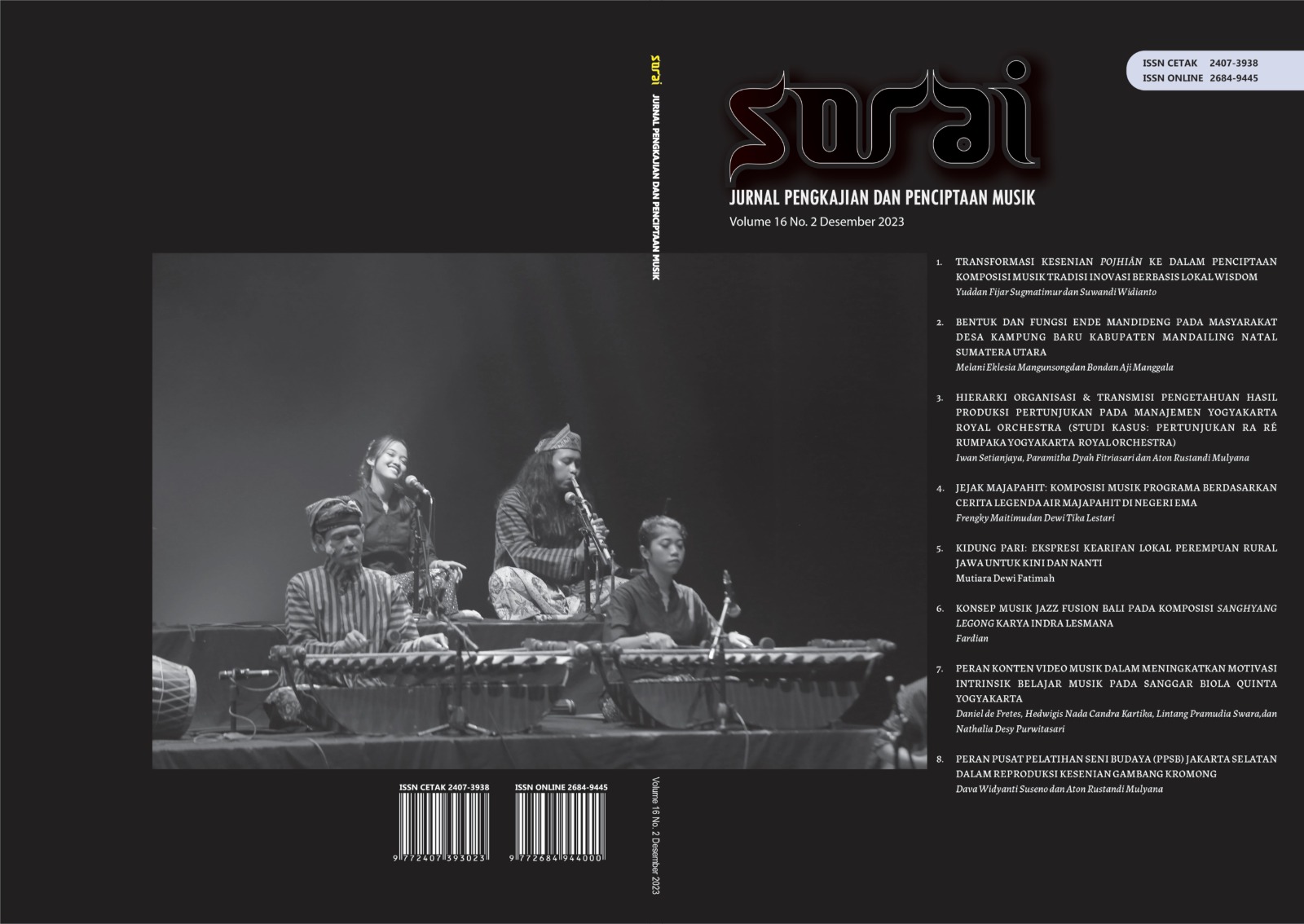PERAN PUSAT PELATIHAN SENI BUDAYA (PPSB) JAKARTA SELATAN DALAM REPRODUKSI KESENIAN GAMBANG KROMONG
Main Article Content
Abstract
Along with the development of the capital city, the Betawi people and their culture have faced various challenges related to their identity and existence as “natives”. This condition has had a lot of influence on the condition where traditional arts are no longer alive and developing, one of which is Gambang Kromong. The Provincial Government of DKI Jakarta with various other interests, then carried out cultural preservation through the Cultural Arts Training Center (PPSB). This study describes how the Gambang Kromong Training Program is organized by PPSB, through the ethnographic method which has been carried out since 2018, then by data collection techniques through observation, interviews, and literature review related to the research object. The results of the collected data are then analyzed through the perspective of the theory of cultural reproduction and the theory of hegemony. The PPSB Gambang Kromong Training Program in the 2016-2019 period has succeeded in forming an ideal cultural reproduction system. The stages of the program cover quite a lot of aspects and various factors that also support a cultural reproduction effort, especially for the Gambang Kromong traditional arts in DKI Jakarta. Unfortunately this program had to stop due to policies that forced restructuring. The role of PPSB, which is part of a political society, unfortunately has to lose in the hegemony game of the institution above it, and this also has an impact on civil society which includes art galleries, schools, traditional arts practitioners, and the Betawi community in general. Policies that show the government’s inconsistency in carrying out the preservation and reproduction of culture, eventually add to the question in terms of cultural programs to the interests of the institution alone.
Downloads
Article Details

This work is licensed under a Creative Commons Attribution-ShareAlike 4.0 International License.
Copyright
Authors who publish to Sorai: Jurnal Pengkajian dan Penciptaan Musik agrees to the following terms:
- Authors retain copyright and grant the journal right of first publication with the work simultaneously licensed under a Creative Commons Attribution License (CC BY-SA 4.0) that allows others to share the work with an acknowledgment of the work's authorship and initial publication in this journal.
- Authors can enter into separate, additional contractual arrangements for the non-exclusive distribution of the journal's published version of the work (e.g., post it to an institutional repository or edit it in a book), with an acknowledgment of its initial publication in this journal.
- Authors are permitted and encouraged to post their work online (e.g., in institutional repositories or on their website) before and during the submission process, as it can lead to productive exchanges, as well as earlier and greater citation of published work.
References
Ananda, D. R. (2017). Eksistensi Gambang Kromong: Masyarakat Betawi Setu Babakan Kecamatan Srengseng Sawah Jakarta Selatan. Universities Andalas.
Ayumi, H. A. (2018). Pertunjukan musik Gambang Kromong Grup Savera Entertainment Di Klenteng Ngo Kok Ong Cibarusah Kabupaten Bekasi. Universitas Pendidikan Indonesia.
Bates, T. R. (1975, April – June). Gramsci and the Theory of Hegemony. Journal of the History of Ideas, 36(2), 351-366. University of Pennsylvania Press. http://www.jstor.org/stable/2708933
Briggs, J. (2005). The use of indigenous knowledge in development: problems and challenges. Progress in Development Studies, 5(2), 99-114 University of
Glasglow.https://doi.org/10.1191/1464993405ps105oa Diananda, A. (2018, Januari). Psikologi Remaja dan Permasalahannya. ISTIGHNA, 1(1), 116-133. PISSN 1979-2824.
Faruk. (1999). Pengantar Sosiologi Sastra dari Strukturalisme Genetik sampai Post Modernisme. Yogyakarta: Pustaka Pelajar.
Harlandea, M. R. (2016, Juni). Sejarah dan Enkulturasi Musik Gambang Kromong di Perkampungan Budaya Betawi. Jurnal Seni Musik, 5(1), 22-30.
Herwan, J. O. I. (2017). Lagu Ondelondel dalam Kelompok Kesenian Renggong Manis di Jakarta. Institut Seni Indonesia Yogyakarta.
Kusumaningrum, A. (2018). Peranan Negara dalam Pelestarian Seni Pertunjukan Tradisi Jawa Yogyakarta 1945-1984. Universitas Diponegoro Semarang.
Laksmiwati, H., Rusjiono, Mariono, A., & Arianto, F. (2022, November). The Influence of Collaborative Learning on Social Skills in Higher Education. International Journal of Multidisciplinary Research and Analysis, 5(11), 2997-3000. DOI: 10.47191/ijmra/v5-i11-05
Miharja, D., Mulyana, M., & Izzan, A. (2019, Desember). Islam, Ethnicity, and the Politics of Cultural Identity among Betawi Muslims in Jakarta. Jurnal Ilmiah Agama dan Sosial Budaya, 4(2), 132-143. 10.15575/jw.v4i2.4718
Monika, I., Nawawi, J., Arifin, I. (2011, Juli). Kebijakan Pemerintah Daerah dalam Pelestarian Kesenian Tradisional di Kota Makassar (Jurnal Ilmu Pemerintahan), 4(2), 63-96.
Nash, R. (1990). Bourdieu on Education and Social and Cultural Reproduction. British Journal of Sociology of Education, 11(4), 431-447. Taylor & Francis, Ltd. Retrieved May 18, 2023, from https://www.jstor.org/stable/1392877
Passeron, J.-C., & Bourdieu, P. (1990). Reproduction in Education, Society and Culture (P. Bourdieu, Ed.). SAGE Publications.
Sugihartati, R. (2019, Januari-April). Gambang Kromong sebagai Identitas Orang Cina Benteng. Jurnal Desain, 6(2),129144.10.30998/jurnaldesain.v6i2.2997
Sugiono, M. (1999). Kritik Antonio Gramsci Terhadap Pembangunan Dunia Ketiga. Yogyakarta: Pustaka Pelajar.
Sukotjo. (2021, Maret). Dinamika Perkembangan Musik Gambang Kromong Betawi. Selonding (Jurnal Etnomusikologi), 17(1), 1-26.
Tang, Y. (2017, Juli 11). A Summary of Studies on Organizational Legitimacy. Open Journal of Business and Management, 5, 487-500. Scientific Research Publishing. https://doi.org/10.4236/ojbm.2017.53042
Tim Penyusun Pedoman Dinas Pariwisata dan Kebudayaan DKI Jakarta. (2019). Pedoman Umum Penyelenggaraan Pelatihan Seni dan Budaya Pada Unit Pengelola Pusat Pelatihan Seni dan Budaya. Dinas Pariwisata dan Kebudayaan Provinsi DKI Jakarta.
Webster, A., Bilton, T., Bonnett, K., Jones, P., Skinner, D., & Stanworth, M. (1996). Introductory Sociology (3rd ed.). Macmillan Education UK. Dol 10.1007/978-1-349-24712-7
